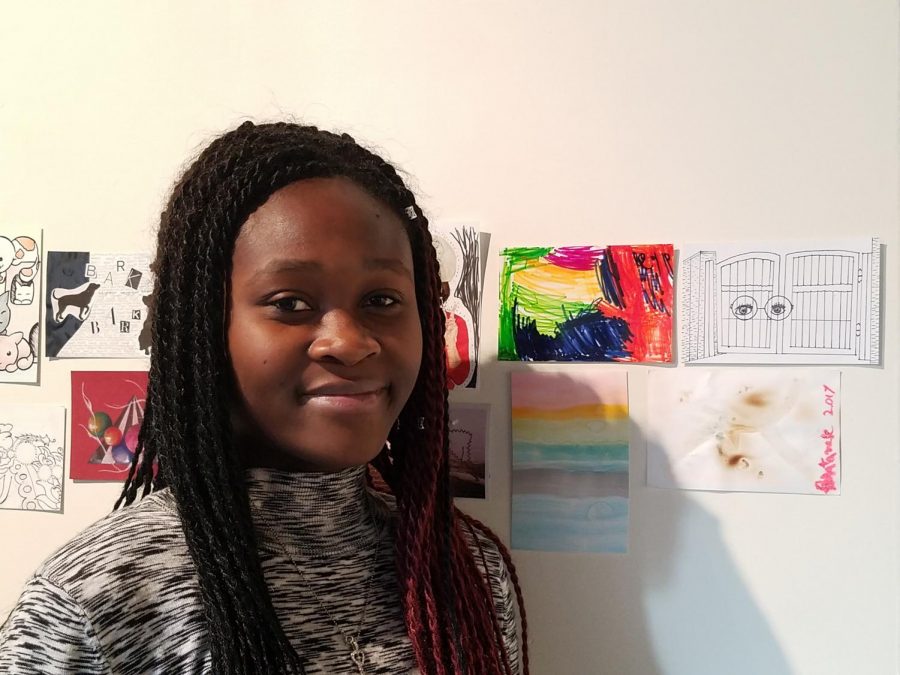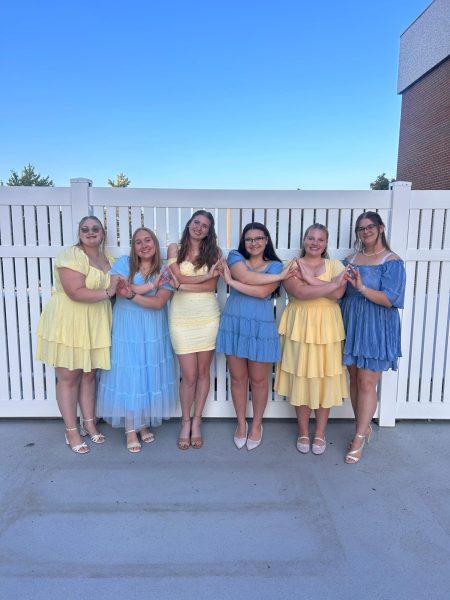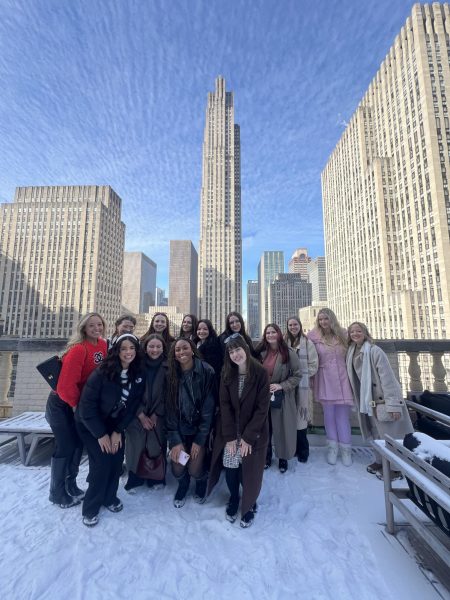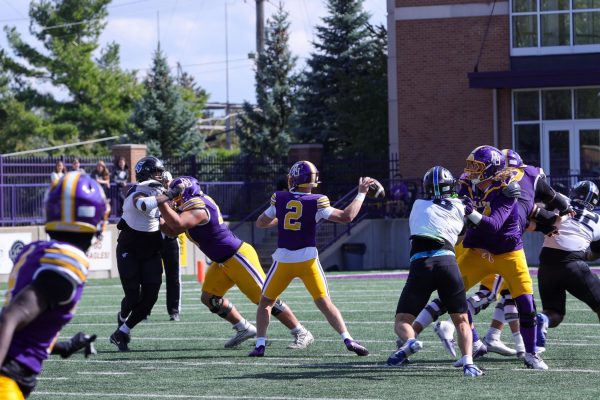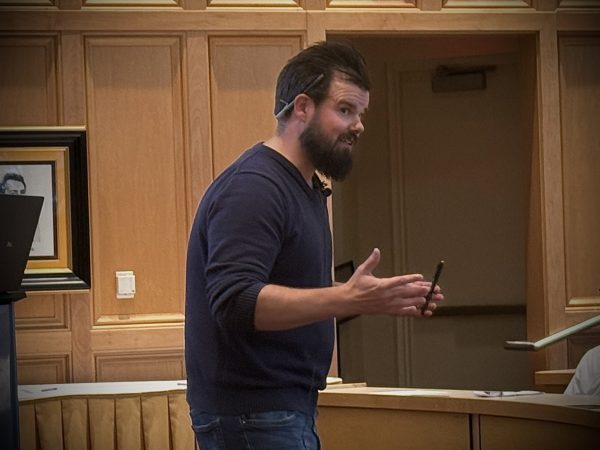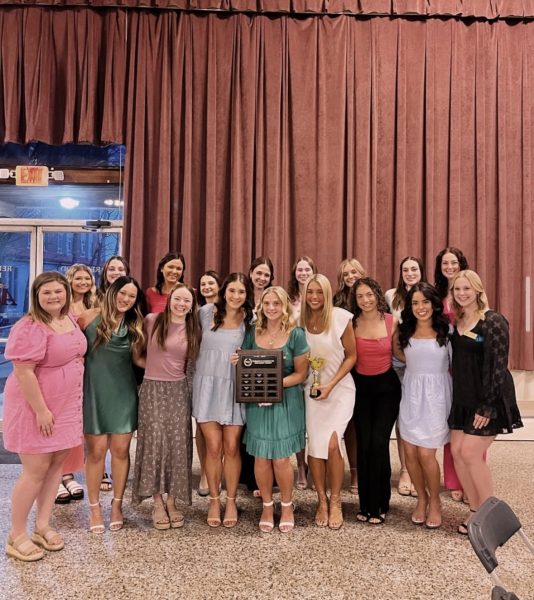Connections with neighbors: International “mail art” show comes to Ashland University
“It’s very important to know the neighbor next door, and the people down the street, and the people in another race.”
These words from Maya Angelou – an American poet, memoirist and civil rights activist – continue to ring true three years after her death.
World data, records and censuses collected in 2016 show almost 7.5 billion people live on Earth. It is nearly impossible to determine the exact number of societies, cultures and ethnic groups on this planet since there are so many people, but they all coexist with each other.
Symbols of the unity of humanity have found their way to this small campus in a small town, all due to an international mail art show that shows connection through our neighbors. Entrants mail postcards to the gallery from all over: there are several submissions from out of the country and quite a few more from out of the state, and several students participated in the exhibit as well.
Senior Miki Yamamura, a business management major, was attending an art club meeting when the club president, Kiana Zeigler, told her about a new art exhibition with the theme of bringing people together, regardless of diversity, religion, or race. She got involved by creating a postcard for the event.
Yamamura expressed great interest in the theme and making a postcard because she feels international students “can be outsiders in America.” International students come from different cultural backgrounds than the ones typically found in America, and sometimes that can feel exclusive. Her goal was to create a postcard that spoke well to the theme.
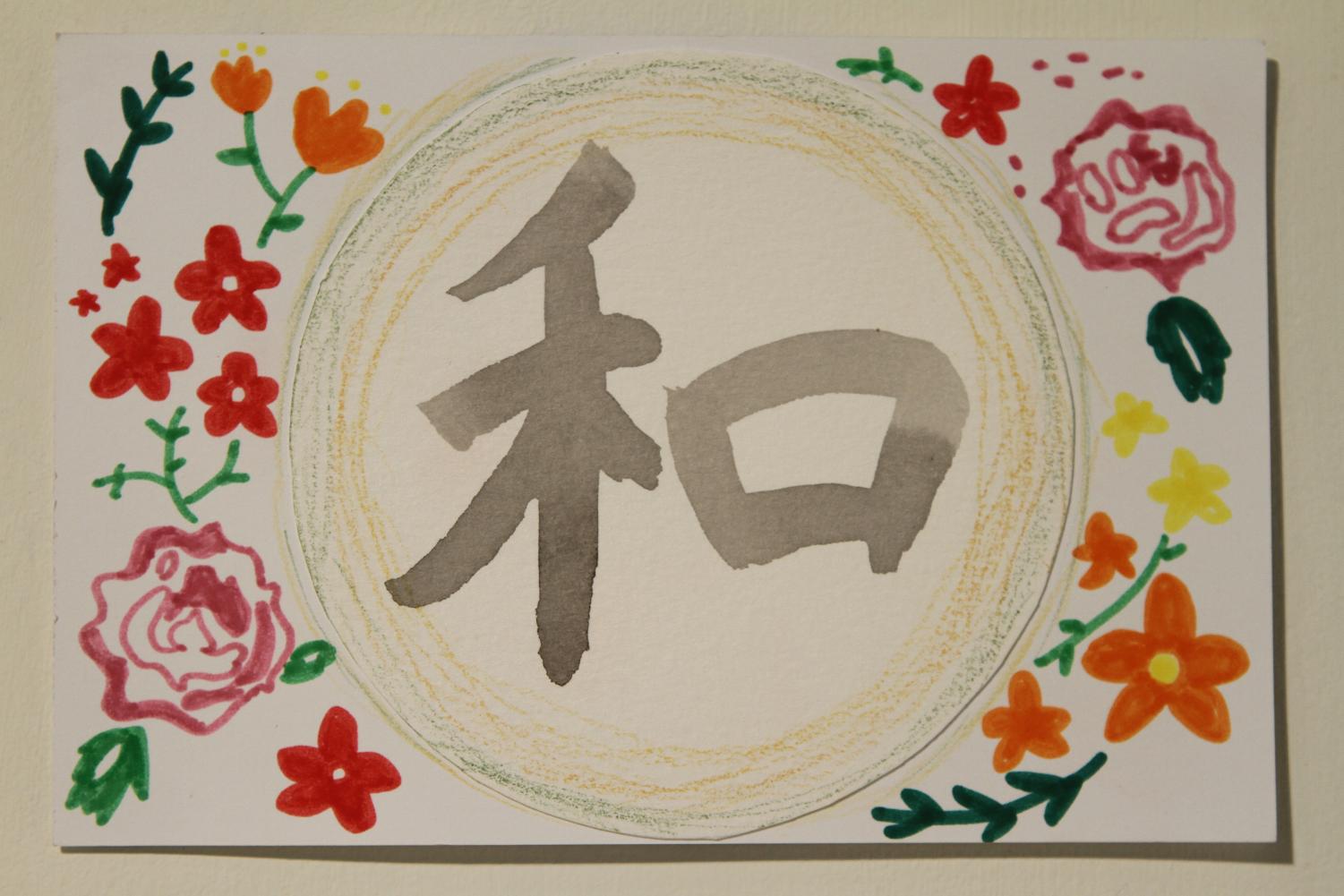 Kaitlyn Moore
Kaitlyn Moore
Unique brushstrokes came together to form a powerful symbol, a beautiful word surrounded by delicate white petals of small flowers. Using traditional Japanese ink, sumi, and a japanese brush, fude, to make the letter, Yamamura wanted to make authentic art and represent herself and her culture.
“When I think that theme, that letter, harmony, comes to mind,” she said. “Ashland should be the place which has harmony and collaboration between American people and international students. Most people coming to the gallery will be American people, so I want them to know we are here. I want to show different cultures to Americans so they hopefully understand a culture that is different from theirs and appreciate it.”
That is part of what she is doing for her internship here with International Student Services. She said her job is trying to build a bridge between the American and International community and foster open-mindedness and community. “Thy Neighbor” aims to accomplish this by accepting art submissions that show those connections and encourage active engagement in our communities.
Another student, Iman Ali, was born and raised for 14 years in Saudi Arabia and then came to America to study. As an art lover, Ali saw Thy Neighbor as a chance to show others the blends of culture, race and religion she experienced first hand.
“I love art, and the prompt was really of interest to me. It covered a topic that is very controversial. Thy Neighbor spoke to me,” she said. It hit really close to home one day while she was in Wooster with a friend and they heard some interesting news.
At the Wooster Inn relaxing at the bar with her friend, the pair saw on the local news broadcast that King Salman of Saudi Arabia said women could drive.
“I was totally shocked and in disbelief because I didn’t think I would be alive to see this,” Ali said.
Growing up in Saudi Arabia, Ali recognized women do not have many rights. One was the right to drive. It is 2017 and Ali said the whole situation is “kind of ridiculous.” It was even harder to believe after talking to a couple at the Inn after she and her friend saw the news. They asked Ali if women in Saudi Arabia could eat, could educate themselves and if they had other “basic” rights.
“It was ridiculous…” she said. “We found out that there’s all these restrictions…it’s like, what’s the point of even allowing it? Yeah they can drive, but can they really? I won’t believe it until I go to Saudi Arabia and see women driving, because I know how the culture is and I know how men think there. One very popular male cleric just said women driving harms their ovaries. It infuriates me.”
Traditionally, Saudi women either had to pay for drivers to get to work or have a male relative or husband take them. There are also “guardianship laws” that give male guardians (brothers, husbands, fathers, and even sometimes sons, no matter the age) tight control over Saudi women. Often they cannot work, travel or study abroad, or even get certain medical procedures without consent of their male counterpart.
While women are legally permitted to go through the steps of getting a licence and are permitted to drive themselves, they must ask for permission to travel from the men in their families.
In Saudi Arabia, there are a few groups of rebels, Ali said. Some Saudi women rebelled by driving, and were punished by the law, because of the lack of rights. Ali was not eligible to drive at the point she left Saudi Arabia, but the time she arrived in America she was able to get her permit and licence right away. Saudi Arabia is the last country where women are restricted from driving.
“It wasn’t a conflicting thing for me growing up. Yeah, I thought it was completely unfair and unjust, but it wasn’t something personally bothering me,” she said.
Her postcard describes a hopeful scene between long distance friends: a Saudi woman and an American woman. The Saudi woman says “salam,” which is a greeting that means “peace.” Speech bubbles spill out of their cutouts as the Saudi woman plans a road trip with her American friend, since she is now able to drive without needing a husband or another man to assist her.
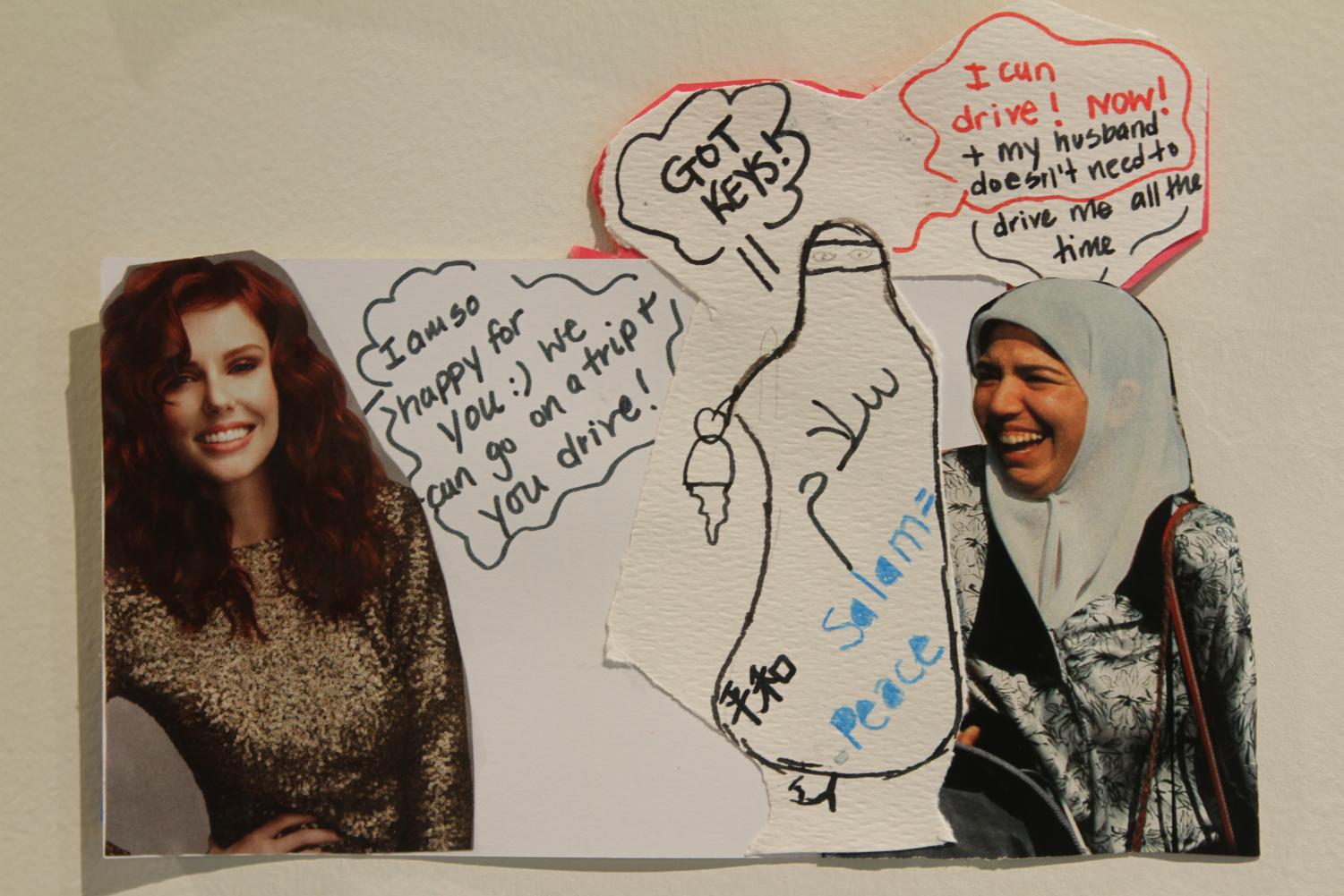 Kaitlyn Moore
Kaitlyn Moore
Ali knows the culture, how the people think and “how narrow minded their thoughts are.” She said people in Saudi Arabia, especially men, want what they want and one way or another they will get it, and they can demand and enforce a specific group of people act or behave in certain ways. The guardianship laws, and the cultural reinforcement behind them, are not going away anytime soon.
“I was just in disbelief as I was drawing this. Like, is this real? Will this actually happen? Would she actually be able to take her friend on a road trip in Saudi Arabia?” she said.
Lifting the ban was a huge step in achieving more rights for women, but it is as frustrating as it is satisfying “because Saudi Arabia was the last country that banned women from driving.” Coming from a Saudi woman who travelled to America, it was clear to Ali that driving is taken for granted, something everyone treated like a basic right.
“I want people to see that even in 2017 this is an issue, to see how ridiculous it is for this to be happening. I know people here take driving for granted. It’s also for awareness, to show people what saudi women can do.”
One AU art professor felt particularly moved to create and submit a postcard. Priscilla Roggenkamp, as an art professor for 13 years now, has had annual opportunities to participate in the faculty show every January, but this unique exhibit gave her a new opportunity “to respond to someone else’s idea, something I don’t usually do, something fun and different.”
Roggenkamp’s submission was actually two postcards that connected with a painting of a river, an idea inspired from a metaphor in Walking on Water (written by Madeline L’angle, author of “A Wrinkle in Time”). Tributaries float in the winding river, each carefully labeled: love, death, family, and hope, just to name a few.
“No matter who we are. They all go into the river,” she said. “This river is like humanity. That’s what I was thinking of. The quote said something along the lines of ‘it didn’t matter if you were a great or small artist your purpose in life was to feed the river, the idea of creativity and humanity, and we all have to do our part.’ I changed her idea to being more about humanity, but we are all the same and we feed the same river.”
Roggenkamp wanted to look at things that separate people when they are not looking at humanity in a positive way and wanted to highlight the commonality of experiences. Anyone will tell you that reading the news is depressing sometimes, “certainly lately, about immigrants, women, blacks being discriminated against,” and it was sobering to think that a hurricane was what it took to pull people together. Hurricanes are indiscriminate, they destroy everything in their path without care.
From the beginning of her life, Roggenkamp was taught all people have value and should be treated well.
Knowing your neighbors resonated deeply within her, because even though she did not go through any specific trauma, the theme struck a chord in her heart.
 Kaitlyn Moore
Kaitlyn Moore
“I have always been interested in how we treat each other, trying to understand people from other countries and backgrounds, and I worry about the climate of our country. We should know our neighbors,” she said. “I would hope my postcards communicate a reminder that we aren’t so different after all.”
Freshman nursing major Abigael Fabiku also created a postcard for the mail art show.
“Dr. Petry told our art class that we were going to do a postcard for the gallery, and it was going to be about neighbors, and I have never really thought about neighbors before,” she said. “You would be surprised about how much thinking goes into what a ‘neighbor’ is, it is a simple word but when you think about it, it’s much more than that.”
A simple pencil drawing of a cast iron gate with a pair of eyes leaves much to the imagination of the viewer. Fabiku created a postcard to encourage people to think about what the gate meant to them. Gates can either keep people in or keep people out, and that is all up to interpretation.
“I’m from Nigeria, and when I think of my neighbors in Nigeria, we all know each other and your neighbors treated you like their family,” she said. “I moved here, into an apartment, and I barely know what my neighbor even looks like. So when Dr. Petry said to describe what a neighbor was to us, I couldn’t really decide what I wanted it to be, friendly or not friendly, so I decided to draw a gate.”
The pair of eyes symbolizes a person inside the gate looking out into the world. The age old maxim “don’t judge a book by it’s cover” comes to mind looking at this postcard. Fabiku said Nigeria, like America, has gated and ungated houses, but they mean two different things in the two different places.
“In Nigeria, the gated houses are not unapproachable, they’re no different from ungated houses. In America I feel like it is a cultural difference, but gates are different here, they’re secluding,” she said.
Fabiku’s message, the message of Thy Neighbor, is to approach your neighbor.
“Be nice. Some people have gates but you can’t judge them by that.”


